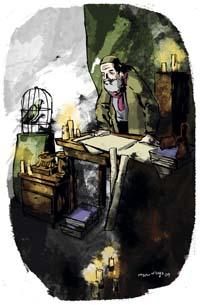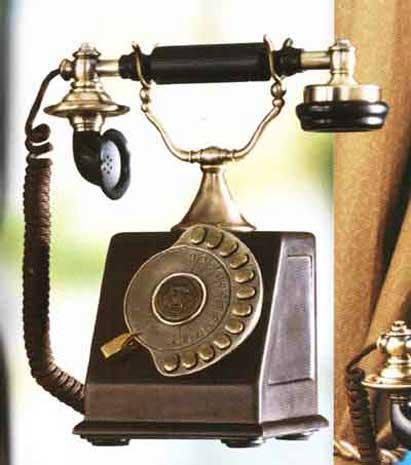Meucci phone
2009/11/01 Etxebeste Aduriz, Egoitz - Elhuyar Zientzia Iturria: Elhuyar aldizkaria

Although he arrived in New York with enough money, luck was not favorable for Meucci. Because of various claims and fraud, the money escapes. And in 1874 he did not have the opportunity to renew the patent application of his telephone requested three years earlier, much cheaper than the patent itself. Two years later he felt anger when a young Scottish man knew the patented invention. Alexander Graham Bell was a young man who patented the phone.
The story of Meucci's telephone began in Havana. There were immigrants Antonio Meucci and Ester Mochi, who came in 1835, pushed by the political situation, leaving Florence behind forever.
He worked in several theatres in Florence, as a stage technician, and also when he arrived in Havana, he began working at the Gran Teatro de Tacón.
But Meucci's work was not limited to theatre. Inventor and passionate experiencer. During his years in Havana he invented a water treatment system and a new electroplating technique. He also investigated "electromedicine." He set up a laboratory at the back of the theater and began researching the healing of electric pulses. His secret was in the exact control of the power and duration of the pulses. According to Meucci, the application of short and small pulses could treat pain and some diseases. Moreover, this technique could contribute to the regeneration of tissues and bones. Meucci’s services soon became popular in Havana.
In 1849, Meucci had a surprise. A migraine patient looks for a remedy. Meucci sat him in the chair and placed a copper electrode in his mouth between his teeth and told him to hold the other with his hand. The electrical pulses were produced from the room next to which the patient shouted when he went to treatment. Meucci went crazy: that cry came from the cable!
He immediately began to investigate this phenomenon. "I realized," he said years later, "that I had managed to transmit the word through a conductive thread attached to batteries, and immediately I called him a talking telegraph."
The following year, the theatre contract was not renewed and the marriage decided to go to the United States. There, Samuel F enjoyed great prestige. B. Mors, thanks to his invention, and Meucci also intended to develop and exploit his discovery.
They settled in Staten Island, New York. He bought his house and set up a candle factory. The candles did not give him much money, but they did to live and move forward with their experiments. In the coming years he worked in the workshop next to the house to improve that talking telegraph. And, around 1854, he installed a prototype in the passage from the workshop to the room of the house, to be able to communicate with an invalid woman in bed by rheumatoid arthritis.
This is described by Meucci himself: "The essence of invention is a vibratory diaphragm and a magnet electrified by a spiral thread. By vibrating the sounds of the word, the diaphragm, in each vibration, acts on the magnetic current, generating very fast interruptions of electricity, such as diaphragm vibrations. These current changes, upon reaching the other end of the thread, cause vibrations analogous to the receiving diaphragm, which reproduces the word."
He telephoned this invention. But we had to improve, because the words were not understood well. So he kept working. In the coming years he created about 30 prototypes.
He also invented paraffin candles and in 1860 launched the world's first paraffin candle factory. But the frauds of some debtors led the factory to defeat and Meucci ran out of goods. The following year they auction their house. Fortunately, the buyer of the house let him continue there without paying rent.
Meucci did not resign himself to the telephone. And in December 1971 he founded Telettrofono Company, along with three other Italians. But the company had a short tour. When it came time to apply for the patent, Meucci only obtained 20 dollars, provided by a partner of the company. For the payment of the patent it took 250 dollars, and instead, on December 28, 1971 it applied for a patent whose cost was 10 dollars.
Patent application in hand, Mr. Edward B. Vice President of Wester Union Telegraph Co. Meucci went to Grant and gave him the telephone designs to see if they could move forward together. For two years Meucci only heard stretches and excuses. And in the end Grant told him that all the material Meucci had left had been lost.
When Bell patented the phone in 1976, Meucci began a passionate judicial struggle against him. In one of those trials it was published that Bell had a hidden agreement with Wester Union Telegraph Co. to allocate 20% of Bell's benefits. In 1887, in another trial, he condemned Bell for fraud and reasoned Meucci, but it did not serve many. In fact, Meucci had lost all his rights since 1774, when he had not renewed his patent application. In 1889, the case closes with the death of Meucci and Bell's empire continues.
P. S: In 2002, the U.S. Congress officially recognized that Antonio Meucci was the first to hit the phone. The resolution gives several reasons for this. Among other things, it is mentioned that Bell worked in the same lab where Meucci's designs were lost, and it is said that if Meucci could have paid a $10 patent application, Bell could not get the patent.

Gai honi buruzko eduki gehiago
Elhuyarrek garatutako teknologia




